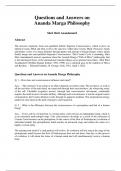Questions and Answers on
Ananda Marga Philosophy
Shrii Shrii Anandamurti
Abstract
The universe originates from non-qualified infinite Supreme Consciousness, which evolves an
infinite Cosmic Mind and then evolves the universe within this Cosmic Mind. Protozoic minds
and bodies evolve over many lifetimes through plants and animals to human beings, whose minds
finally merge into non-qualified Supreme Consciousness. This Cosmic Cycle is unending. Shrii
Shrii Anandamurti answers questions about his Ananda Marga (“Path of Bliss”) philosophy that
is the ideological basis of the international Ananda Marga socio-spiritual movement. Shrii Shrii
Anandamurti (Prabhat Ranjan Sarkar) (1921-1990) was a spiritual guru in the tradition of Shiva
and Krishna. – Richard Gauthier, St. George, Utah, USA. April 3, 2022.
Questions and Answers on Ananda Marga Philosophy
Q. 1 – How does unit consciousness influence unit mind?
Ans.: – The existence of an action or an object depends on witness-ship. The existence, as well as
all the activities of the unit mind, are expressed through unit consciousness, the witnessing entity
of the self. Citishakti (cognitive power), through unit consciousness (jiivatman), continually
inspires the mind to move towards subtlety. Although unit consciousness is not the original source
of inspiration, the Cosmic Ideation works through its apparent medium. This inspirational energy
guides the unit mind on the path of progress and expansion.
Q. 2 – What is the difference between the consciousness of a protoplasm and that of a human
being?
Ans.: – Every cell in a living body is a living entity; each one has an independent mind, which is
in an extremely undeveloped stage. Unit consciousness develops as a result of the reflection of
Cosmic Consciousness on the protoplasm. In the course of the flow of Pratisaiṋcara (evolution of
individual minds) this protoplasmic mind reaches an advanced stage and attains the status of a
highly evolved entity.
The unexpressed mind of a sand particle will evolve. Its evolution will not stop at the stage of the
protoplasmic mind because the flow of Pratisaiṋcara does not end there. One day, in this process
of evolution, it will attain the status of a human mind and will simultaneously receive a human
body.
, The mental arena of a human being is not merely a collection of many mental arenas of many
mental protoplasms; rather it is an independent entity, a unit mind. If it were a collection of
protoplasmic minds, it could not be called a unit mind. It would not be possible for a collection of
protoplasmic minds to carry out the functions of a developed human mind. In each protoplasmic
mind there is a domination of Prakrti (supreme creative power) over Puruśa (Supreme
Consciousness) which is further accentuated in a collection of minds. It is absolutely impossible
for this collection of protoplasmic minds to engage itself in meditation or to exercise free will.
Q. 3 – Is there any fundamental difference between mind stuff (citta) and ether (vyoma tattva)? If
so, why?
Ans.: – No, there is no fundamental difference. Both originate from Consciousness. In reality there
is no “non-living” entity: everything has Consciousness. Due to the bondage of Prakrti,
Consciousness sometimes appears to be in the form of the crude five fundamental factors,
sometimes in a subtle psychic form, and at other times in the form of Causal Consciousness. Mind
is that stage of Consciousness where the domination of Prakrti is less than that present in the five
fundamental factors.
Q. 4 – What is the relative importance of “bháva” (ideation) and “jad́ a” (matter) in Shankaraʼs
doctrine of “Máyá” (illusion)?
Ans.: – Shauṋkara tried to disprove a number of theories with the characteristic fervour and
enthusiasm of an over-zealous materialist. This was his approach while attempting to disprove
“Baoddha Vijiṋánaváda”, a highly idealistic theory. While trying to invalidate this theory he
himself became an extreme idealist. According to him the universe is an illusion. Not only that, he
maintained that even the psychic processes of projection and withdrawal are also illusions. The
only reality is “Nirguńa Brahma” (unexpressed Supreme Consciousness). In this respect,
Shauṋkara sounds like some Western philosophers, notably Socrates, Hegel, Berkeley and Kant.
In order to defeat idealism, he himself became an idealist. His theories closely resembled those of
the philosophers preaching empirico-criticism. However, Shauṋkara took his empiricism beyond
the physical world, for, according to him, not only is the physical world an illusion but psychic
feelings are also illusions. He states that the only fundamental substance that lies beyond physical
objects and mental experiences is Brahma – the Nirguńa Puruśa, the Non-Qualified Brahma. Not
even Prakrti, the Supreme Operative Principle, is accepted as the reality. The paradox here is that
Shauṋkara had to use and depend upon that very Máyá which he claimed to be illusory, that same
Máyá which was instrumental in creating this variegated universe.
Q. 5 – What sort of bondage does Prakrti have over Puruśottama? What is the difference between
Puruśottama and Nirguńa Brahma?
Ans.: – Puruśottama is the controlling centre or nucleus of Saguńa Brahma (expressed Supreme
Consciousness). Wherever there is Puruśa, Prakrti is also there in His shelter. Though associated
with Prakrti, Puruśottama is not bound by Prakrti. The expressed form of Saguńa Brahma, under
the bondage of Prakrti, is seen in the process of Saiṋcara and Pratisaiṋcara. Due to the
preponderance of Consciousness in Puruśottama He is sometimes considered as Nirguńa
(unexpressed Supreme Consciousness). However, upon closer observation, it is discovered that




